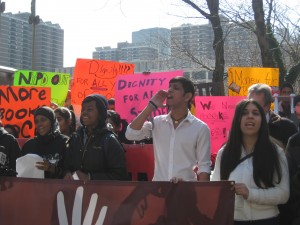Average of Five Students Arrested Per Day at City Schools Last Fall
Resource type: News
Gotham Schools | [ View Original Source (opens in new window) ]

Students and advocates rally at police headquarters after the release of data on arrests and police incidents at city schools. Photo: Gotham Schools
By Rachel Cromidas
Police officers arrested more students and handed out more tickets in schools as the school year got underway, according to new data released today. On average, five students were arrested per day on school grounds between October and December 2011.
Those statistics come from a trove of data the New York Police Department is required to release under a relatively new law mandating the disclosure of information about in-school arrests and suspensions. The first data dump, released in late November and compiled by the American Civil Liberties Union, showed police had arrested or ticketed roughly four students per day on school grounds between July and September.
Both reports show that disproportionate number of black and Latino students were being arrested and ticketed. 74.9 percent of those arrested during the fall quarter were male, and 93.5 percent were black or Latino. Black and Latino students make up about 71 percent of students in city schools.
Over the 55 school-day period between Oct. 1 and Dec. 31, NYPD reported nearly 2,300 incidents. Of those, 279 resulted in arrests and 532 in summonses. According to NYCLU’s analysis, 63 percent of summonses were for disorderly conduct. of the arrests, about 120, or 40 percent, were labelled as assault or related to assault.
This afternoon, politicians joined representatives from the ACLU’s New York chapter and several student advocacy groups to decry the statistics as evidence that police involvement in schools leads to racial discrimination and a fearful environment. As a ring of police officers looked on, advocates rallying outside of NYPD headquarters said they would like the City Council to revisit the issue of the NYPD role in schools now that the council’s Student Safety Act is is in effect.
“These students are being arrested for misbehaving,” said Donna Lieberman, executive director of the New York Civil Liberties Union. She noted that black students were nine times more likely to be arrested at school than their white peers, according to the statistics, drawing a comparison between police actions in schools and the city’s controversial stop-and-frisk policy — a Bloomberg administration policy that is set to play a prominent role in the 2013 mayoral race. She also said she expects the numbers to climb to 2,500 students arrests and summonses total by the end of the academic year.
Sarah Arvey, a middle school teacher in Queens and a member of the advocacy group Teachers Unite, said students of color at her school, Catherine and Count Basie Middle School in Jamaica, Queens, have come to expect encounters with police officers and suspensions.
Speaking of one student, she said, “The routine of experiencing punitive consequences has convinced him that regardless of his abilities or educational potential he and his peers were better off expecting their fate as criminals instead of proving their worth as students. It would be cheaper and less time-consuming to address their needs in a positive way within the classroom setting.”
The report said 18.6 percent of those students arrested were middle school-aged.
Arvey told me that she has heard of other educators successfully diffusing conflicts between students through peer and community mediation tactics and “restorative justice circles” or peace circles, which involve bringing opposing parties together to discuss and resolve their issues among third-party community members and fellow students.
Adama Diallo,17, a junior at Bronx International High School, told me peer mediation has improved the environment at her school, and could be adopted by others. She and several other students received peer mediation training organized through the Urban Youth Collaborative, she said, and then applied what they learned to conflicts at school. For example, when two students once threatened to fight each other after a disagreement in the cafeteria, Diallo said she encouraged them to find a peaceful solution by talking with other students in a group.
“They came up with a compromise, and now they’re friends,” she said.
NYCLU, Urban Youth Collaborative, and DSC-NY are Atlantic grantees.